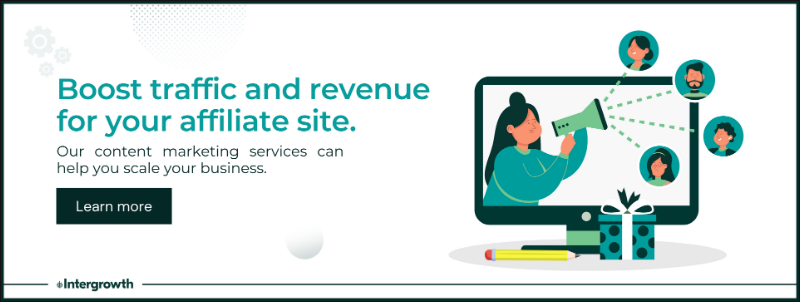- What are the most common affiliate marketing mistakes?
- Prioritizing selling over helping
- Publishing low-quality content
- Ignoring/overlooking site speed
- Neglecting readability of content
- Not having a deep understanding of what you’re selling
- Ignoring the SEO basics
- Not utilizing evergreen content
Table of Contents
Do you wish you could make money online while writing blogs from the beaches of Phuket?
This is the first thought that comes to mind when we hear about affiliate marketing. They often tout the easy living and luxurious travels that come with finding a niche, creating great content, and referring site visitors to affiliate products.
But is it really THAT easy?
The short answer is no.
Affiliate marketing takes a lot of industry knowledge, patience, and proper content strategy to get it right. By avoiding the biggest mistakes that most affiliate marketers make along the way, you’ll be equipped with everything you need to create a successful business.
Below, we share the best advice to build a successful affiliate program on content tips, SEO optimizations, and much more. Check out the 7 most common mistakes affiliate marketers make and learn how to avoid them.
What Are the Most Common Affiliate Marketing Mistakes?
- Prioritizing selling over helping
- Publishing low-quality content
- Ignoring/overlooking site speed
- Neglecting readability of content
- Not having a deep understanding of what you’re selling
- Ignoring the SEO basics
- Not utilizing evergreen content
We’ll explain each of these points more in detail below.
Prioritizing Selling Over Helping
It’s easy to develop the mindset that getting conversions/sales is your number one priority as an online marketer.
Unfortunately, this mindset is what results in mediocre content and poor results.
Instead, you should focus on creating high-value content above all else. Focus your writing around the reader’s intent, putting them first. Instead of explaining features, focus on benefits to the user.
Avoid user friction wherever possible. Banner ads have a time and place, but are they worth frustrating your visitors to the point of no return? Will your pop-ups be deemed as intrusive content in the eyes of Google?
Every outbound sales tactic, whether it’s a banner ad or a notification request, comes with consequences. It’s up to you to decide whether the user friction is worth it.
Publishing Low-Quality Content
Whether you like it or not, your content is your product as an affiliate marketer.
Clicks are simply a result of great content that readers deem valuable and credible. Above all else, affiliate marketers should strive to produce high-quality content. Far too many affiliates think that 10 mediocre posts will outperform one great post. This isn’t the case.
When it comes to producing high-quality blog posts, there are a few steps to keep in mind when attempting to outrank the competition in the SERPs. The first is to identify a topic that is feasible to rank for, aka the “low hanging fruit.”
Once you’ve identified the topic, you’ll need to do keyword research to uncover what it will take to outrank the competition.
Ask yourself the following:
How many root domain backlinks do they have? Use a tool like MozBar to uncover how many backlinks the competition has.
What’s the word-count of the top-ranking posts? The average first-page result is 1,890 words. Keep this length in mind as a general benchmark when writing your own content.
Does your post include an image? Studies show that a post with at least one image ranks higher than those that don’t have any. How’s the readability of the post?
Once you’ve uncovered these details, you’ll have the framework you need to write a top-ranking piece of content.
From there, put as much time into promoting that newly published article as it took to write it:
- Share your new guide on social media
- Send it out to your email list
- Do link building outreach to relevant bloggers to encourage them to link back to your guide
Related: See how we build content marketing strategies for our clients
Ignoring/Overlooking Site Speed
Did you know that bounce rates increase by 50% if your web page takes longer than 2 seconds to load? We all know that users are impatient. If your site speed keeps them waiting, they sure as hell won’t wait around and your bounce rate will be compromised.
Head over to GTMetrix.com to see a breakdown of what could be causing your site to load slowly.
Most of the time, a slow site can be attributed to server response times, large files, or method of content delivery. If you’re on WordPress, there are a few plugins we find ourselves recommending time and time again to help.
- Imagify If large images are the issue, we’ll use Imagify to compress the files as much as possible without sacrificing the quality.
- WP Rocket: For content delivery, we’d recommend setting up browser caching and testing out delaying the rendering of CSS and JavaScript with WP Rocket. As a quick word of caution, altering JavaScript and CSS rendering can cause issues with your website functionality, so we’d recommend reaching out to your development team or an SEO expert to help.
- Cloudflare CDN: When in doubt, implement a CDN via the Cloudflare WordPress plugin to speed up the delivery of content.
For Shopify sites, reach out to the team at Convertly. They offer similar site speed optimizations for Shopify websites.
Not every site will load in under 2 seconds, but there are actions you can take to help improve your site speed regardless. Not only will quicker load times help with user experience, but subsequently rankings and conversion rates as well.
Neglecting Readability of Content
In the age of shorter attention spans, visitors have a lower tolerance for confusing or hard-to-read content. When it comes to font size, avoid using any font smaller than 16pt, particularly for mobile users.
However, the font size isn’t the only thing to keep in mind for readability. You should also consider line height, serif vs sans fonts, and tracking in your blog templates. When in doubt, the age-old “rule of thumb” is using a serif font for paragraph text.
Strive to avoid long sentences and paragraphs. Studies have shown that after 25 words a sentence becomes difficult for people to read. The same approach applies for paragraphs, where you should keep them to 4 sentences or less whenever possible.
If you have to look up a word to use it when writing, don’t include it. Studies show that U.S. readers prefer a seventh to eighth-grade readability level. This applies to readers with a higher academic level as well. Before you hit publish, head over to Hemingway and see what grade your content is scoring.
Related: Read about the affiliate marketing tools that the world’s top affiliate marketers use every day.
Not Having a Deep Understanding of What You’re Selling
One of the common mistakes we often see with affiliate marketers is not investing the time to learn about what they’re writing about.
Don’t underestimate the fact that your readers are savvy. With the world’s information at their fingertips, potential customers will be ready and willing to call your bluff if you don’t know what you’re writing about.
So how do you combat this?
Subscribe to industry-leading blogs, forums, or Google alerts to stay up-to-date on your niche. Head over to Quora or Reddit to find out what questions people are asking about your niche.
Most importantly, equip yourself with the knowledge necessary to earn your readers trust and engagement through your content. This will help in the long run, both in conversions and page engagement in the eyes of Google.
Also see: How to find a niche blog topic to write about
Ignoring the SEO Basics
Publishing a new post without proper SEO is like building a house without any roads to it.
Without the proper title tag and meta description, you’re making it very difficult, if not impossible, for people to find your content. After all, you’re in the business of generating the most traffic possible…aren’t you?
The first step is to optimize your title tag and meta description.
Research the overarching theme of your post and strive to create a compelling title tag and meta description for potential visitors. Think of this as your sales pitch in the search engine results.
The more your title tag and meta description resonates with the user, the more likely they are to click through to your page. If you’re on a WordPress website, this can be as simple as installing the Yoast SEO Plugin. Then you’ll need to focus on writing compelling copy in your meta description and title tag. Otherwise, we’d recommend contacting an SEO expert to help with this.
Inlinks and external links shouldn’t be forgotten either. Internal links help to establish information hierarchy across the site, as well as link equity. As for external links, they are believed to be the most important source or ranking power.
External links are the best way to indicate the credibility and authority of another site’s content in the eyes of Google. Skim through your post and aim to identify opportunities to link to other pages across your site.
Not Utilizing Evergreen Content
The internet moves fast and it’s up to us as content publishers to keep up.
Articles such as “The Best “X” of 2025” have their importance in online marketing. However, you should balance this content with sustainable, evergreen content. Particularly for long-term link building value.
For those who aren’t familiar, think of it as content that has a consistent volume of search queries throughout the year, over a long period of time.
As you could imagine, evergreen content is often a much more competitive space. Other successful bloggers and content marketers are aware of the long-term value, so it can be difficult to compete in this space.
It is also contested that evergreen content is not as valuable for affiliates because most are written around “how-tos” and instructional guides. While there is some validity to this argument, there is still an immense amount of link building value that comes from writing long-form sustainable content. To combat this, you can increase the value of your content even further by incorporating elements such as [2024 Edition] or (Updated for 2024) in the post title.
Give your content strategy a second look. Are you writing mostly specific and timely content? If so, consider writing a few pieces of Awareness Content that will continue to drive link value for years to come.
Learn about the 7 additional content marketing mistakes that cost businesses thousands.
Still, Have Questions?
Do you feel like you’re guilty of committing any of these affiliate marketing mistakes? If so, give your content a second look to see where you can improve on your journey to become a successful affiliate marketer.
If you’re still struggling to generate high-quality search engine traffic through your content, give us a shout on our site.
SCALE YOUR ORGANIC TRAFFIC
Subscribe to our monthly newsletter



